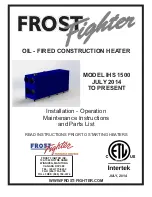
29
FUTERA II INSTALLATION AND OPERATION INSTRUCTIONS
“Static and operating gas pressure required at the gas
valve inlet is between 5" W.C. and 14" W.C. for natural gas
and 11" W.C. and 14" W.C. for propane. If the gas pressure
is above this limit, a lock-up style regulator suitable for dead
end service such as an Equimeter or Fisher must be
installed to prevent increase (creep) of gas pressure when
the units are not operating. This pressure regulator
(supplied by others) may be installed at the service
entrance to each unit or a “master” regulator sized to
handle multiple units may be utilized. Consult local gas
utility or regulator manufacturer for recommendations to
meet specifi c job site requirements.”
Figure 22 – Air Adjustment & Gas Pressure Test Port
Table 9 – Pressure Settings, W.C.
Model
Air Box Pres.
Gas Back Pres.
Size
in
mm
in
mm
500
1.3
33 0.3
7.6
750
2.1
53 0.6 15.2
1000
3.0
76 0.6
15.2
1250
2.1
53 0.3
7.6
1500
2.5
64 0.3
7.6
1750
3.2
81 0.3
7.6
1950
3.4
86 0.3
7.6
Input Rate, Natural Gas
Gas appliances are rated based on sea level operation with
no adjustment required at elevations up to 2000 ft, 610 m.
At elevations above 2000 ft, 610 m input ratings should
be reduced by 4% for each 1000 ft, 305 m.
Check the input rate as follows:
1. Turn off all other gas appliances that use the same gas
meter as the boiler/water heater.
2. Call your gas supplier and ask for the heating value
of the gas.
3. Start the boiler/water heater and let it run for 15
minutes.
4. Using the gas meter and a stopwatch, clock the time
that it takes to burn 10 ft
3
, 0.28 m
3
of gas and divide
this time by 10.
5. Insert the heating value and the time, in seconds, into
the formula below.
6. Input = (heating value, Btu/hr)(3600)/(time, seconds)
7. If the computed rate deviates by more than 5% from
the rated input value of the unit adjust the manifold
pressure accordingly. DO NOT adjust the manifold
pressure by more than 5%. If a proper rate cannot be
maintained without adjusting the manifold pressure
beyond the 5% limit, the main burner orifi ces must be
replaced. If the input rate is too low, go to the next
larger size of main burner orifi ces. If the input rate is
too high, go to the next smaller size.
CAUTION: Never increase the input to the boiler/water
heater above that for which it is rated. Doing so can
cause premature failure of the boiler!
CONTROL DESCRIPTION
Low Water Cutoff
If the boiler is to be installed above radiation or if required
by other codes or regulations, install a low water cutoff in
appropriate piping. Wire the switch and any external
controls in series to the “Interlock” contacts in the control
box, see the wiring diagrams included with the unit
for details. Ensure that the low water cutoff device(s)
will function properly.
Boiler Thermostat
If a thermostat is to be used to control the boiler always
follow the instructions included with the thermostat. Proper
location of the thermostat will ensure effi cient trouble-free
operation of the boiler. Mount the thermostat to an inside
wall at a height approximately 5 ft, 1.5 m above the fl oor.
Avoid placing the thermostat in areas that will not provide
an accurate measurement of the room temperature.
Locating the thermostat behind a door, in an alcove, close
to a source of thermal radiation or in a drafty area will
cause poor or sporadic heating.
For a thermostat that employs an adjustable heat
anticipator, adjust the anticipator to match the current
measured in the thermostat circuit. An increased anticipator
setting may be necessary if the unit cycles frequently. If
the room temperature over-shoots the thermostat setting,
reduce the anticipator setting.
















































